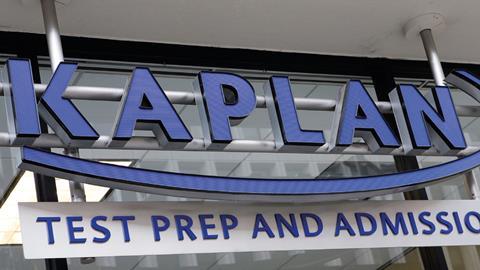Twelve months on from its formal implementation, the jury remains out on whether the Solicitors Qualifying Exam will achieve its noble aims
The low down
In 2015 the SRA set out a radical blueprint to overhaul the education of aspiring solicitors. Allowing trainees to design their own routes to qualification, as long as they pass a final centralised exam, would level the playing field on standards, widen access and boost diversity. It would also be cheaper. One year on from the ‘super-exam’s’ formal implementation, the jury remains out on how effective the SQE is likely to prove in achieving these worthy goals. The SQE certainly offers more routes to qualification, but affluent students can afford the best preparation courses and the first exam results exposed glaring attainment gaps. Hopes that the new system would boost social mobility appear over-optimistic, at least for the moment, given rising costs and a dearth of loans to cover fees.
The Solicitors Qualifying Exam (SQE) was introduced on 1 September 2021 to replace the traditional graduate route into the profession via the Legal Practice Course (LPC) and a two-year training contract.
To qualify as a solicitor, graduates have to pass SQE1 and SQE2 and complete two years’ qualifying work experience (QWE) which has been signed off by a solicitor or compliance officer for legal practice.
The new system also introduced additional routes to qualification aimed at widening access to the profession, boosting diversity and social mobility. These include the solicitor apprenticeship, which enables school-leavers to qualify in six years. Graduates working as paralegals can study for the SQE and qualify without requiring a training contract. Firms are responding to the more flexible system by developing new training models.
Assessments are provided by Kaplan, working in partnership with the Solicitors Regulation Authority: SQE1 is a multiple-choice legal knowledge test, which candidates have to pass before enrolling in SQE2. This assesses practical legal skills and applied knowledge, comprising 16 practical exercises designed to test six key skills in five practice areas. There are four oral assessments and 12 written assessments.
The first SQE assessments were in November 2021 (SQE1) and April 2022 (SQE2). The first SQE2 results were announced on 25 August, and the first successful SQE candidates will qualify as solicitors this month. While only 53% of SQE1 candidates passed the assessment, the pass rate for the SQE2 was 77%, but 390 of the 726 SQE2 candidates did not sit the SQE1. Those who were exempt included foreign lawyers looking to qualify in England and Wales, and paralegals who passed the LPC but did not get a training contract. Some SQE1 candidates did not sit the SQE2 immediately because they needed to get QWE. Therefore the first year’s results for each assessment cannot be considered an accurate indicator of future performance.
'It’s important not just to attract diverse talent, but to support people so that they can realise their potential'
Samantha Kakati, Mishcon de Reya
Julie Swan, director of education and training at the SRA, says this first cohort of SQE2 candidates is likely to be atypical: ‘The candidates taking these early assessments might have a different range of qualifications and experiences from those taking the assessments in future, as the LPC route is still being followed by many. In future, candidates with a degree that integrates preparation for the SQE will start to come through. We have also seen more candidates than we might see in the future who have not had to take SQE1 because of the transitional arrangements.’
Future SQE candidates will also include law firm trainees who have started on the SQE route. Most firms which offer training contracts are currently running the LPC and SQE routes in parallel, while some have introduced variations on the apprenticeship schemes. For example, Weightmans Apprenticeship Academy offers a solicitor degree apprenticeship for school-leavers, a six-year programme which combines an LLB in Law and Legal Practice and the SQE; a graduate solicitor apprenticeship which replaces the traditional training contract; and is about to launch a 24-month paralegal apprenticeship. All three options enable trainees to qualify with all their fees paid.
Extended transitional arrangements mean the LPC route remains valid until 2032. Although this suggests that candidates will be able to choose between the traditional and new systems, this is only an option for candidates who started on the LPC route before September 2021. However, the extended validity of the LPC provides flexibility for people who have taken a career break after the LPC or career-changers who have decided to return to the profession.
‘To be fair to candidates, the transitional arrangements are deliberately long, in part to make sure those who have taken a break don’t have to start again from scratch to qualify,’ explains Swan. ‘It also means anyone who has already started the LPC route has the option to continue down that path if, based on their circumstances, it offers the more practicable option.’
As demand for the LPC route falls, so will the availability of training and preparation, which is a critical success factor and represents a significant part of the cost of qualification in terms of time and expense. While firms and training providers are currently running the two systems in parallel, the big switch will come after the 2021 cohort qualifies.
The right to assistive technology
While candidates with disabilities requiring reasonable adjustments to complete the SQE assessments achieved a 92% pass rate at SQE2 there are still issues to be addressed concerning access.
Jane Burton chairs the Law Society’s Lawyers with Disabilities Division (LDD) and is a member of the SRA’s SQE reference group. She explains that, initially, students who requested assistive technology to sit exams were expected to work instead with an amanuensis – a person who would read out the SQE1 multiple choice questions and answers and input the candidate’s response. This was time consuming and problematic for students unfamiliar with this process. However, after some candidates subsequently threatened legal action, arrangements were made for them to use JAWS screen reading software.
‘Reasonable adjustments are an entitlement under the Equality Act. They are there to support students, not to help them,’ explains Burton. She remains frustrated that despite having first discussed assistive technology with the SRA in 2017, the SQE was up and running before Kaplan started making arrangements for people to use it, and that no other software options apart from JAWS were available. Furthermore, the Pearson VUE centres that Kaplan uses are not set up for assistive technology and are not always easily accessible for people with disabilities, who had to arrive at the exam centre an hour before their assessments.
Julie Swan, director of education and training at the SRA, offers the following guidance: ‘We want people to engage with us with what they may need because it gives Kaplan the opportunity to get the right adjustments. Candidates might also want to discuss their needs with their training provider. If you have clarity on that early, it gives you reassurance at the outset that you will get the reasonable adjustment you need.’
Consistent standards
Consistent, reliable standards were an important rationale for introducing the SQE, ensuring all solicitors who qualify are subject to the same assessments, which are set and marked by Kaplan. Under the LPC, multiple providers were setting and marking exams, meaning consistency was an issue.
Moreover, thousands of firms offer training contracts, which are also subject to variations. The SQE addresses the risk of inconsistency by requiring all candidates to pass the same national exams. And by removing the requirement for a training contract, as consultant and former SRA executive director Crispin Passmore observes, ‘the SQE shifts power towards trainees and candidates by removing law firm or solicitor control on the number of people that qualify as solicitors’.
Signing off QWE is simply confirming that the work has been carried out – it is not assessing knowledge or practical skills, as these are covered by the SQE. So although the exams are not subject to variation, the practical training is less prescriptive. This flexibility broadens the options for trainees to earn as they learn. For example, interim legal resourcing platform Flex Legal’s Flex Trainee scheme, provided in partnership with BARBRI Global, combines online training and secondments to in-house legal departments which are recorded and signed off using a proprietary online tool.
Practical challenges
SQE assessments are provided by Kaplan at Pearson VUE test centres in the UK and internationally, so candidates can attend their nearest centre. However, as Lucie Allen of BARBRI observes, candidates have to attend in person and the format has changed. SQE1 is multiple choice, unlike the LPC exam. BARBRI applied its experience of preparing students for the US bar exam (also multiple choice) and its SQE1 students achieved a 77% pass rate – much higher than the overall rate of 53%, indicating that exam preparation is a critical success factor.
However, assessments have not all gone smoothly. In July an SQE1 exam at the Hammersmith test centre was cancelled at the last minute due to IT issues. As SRA chief executive Paul Philip explained in the Gazette, the SRA is working with Kaplan to minimise the risk of future disruption.
'If the profession is not a level playing field at the exam stage for students, how can we expect the actual profession to be better?'
Baljinder Singh Atwal, Law Society Council member for junior lawyers
Managing costs
The SQE compares well with the LPC when it comes to costs. Also, unlike the LPC which required upfront payment, SQE fees are payable in two instalments of £1,622 for the SQE1 multiple-choice exam and £2,493 for SQE2. These will increase 2.4% in October.
Swan adds: ‘A concern with the LPC route was that many candidates had to commit to taking an LPC – and paying for it – without knowing if they would be able to secure one of the limited number of training contracts. The training contract bottleneck resulted in many having to pay LPC-scale fees upfront, potentially putting themselves in debt, yet finding themselves blocked from qualifying. The SQE opens up options for aspiring solicitors, including to earn as they learn, and all without having to commit to paying LPC-scale fees upfront.’
Law Society vice president Lubna Shuja is nevertheless concerned about the limited funding options for those who need financial support to enter the profession: ‘We have lobbied the government to provide support with funding for freestanding SQE preparation courses and SQE assessments for people who cannot afford the fees. Also, provision should be made for a disabled students allowance. Some course providers have made arrangements with private loan providers, but interest rates can be high.
‘It was initially hoped that the SQE would increase social mobility. However, this seems less achievable given rising costs and a dearth of loans to cover course fees or assessment fees for those who need them.’
Baljinder Singh Atwal, in-house solicitor at West Midlands Police who represents junior lawyers on the Law Society Council, agrees: ‘Our profession should not be made up entirely of people who can afford expensive education. Some preparatory courses may create a culture of high pass rates among affluent students who can pay for extra support and guidance. I’m not a supporter of having to pay for a resit. Students should not be financially penalised to have a second chance.’
Diversity and social mobility
While the SQE was planned to boost diversity and social mobility, a breakdown of SQE1 and SQE2 results identifies challenges. Law Society president I. Stephanie Boyce expressed concern about the continuing disparity between the results achieved in SQE1 by black, Asian and minority ethnic students and their white counterparts.
The first SQE2 results published on 25 August showed a slightly wider attainment gap. Pass rates were 72% for Asian candidates and 53% for black candidates, compared with 85% for white candidates. Shuja says: ‘This attainment gap is concerning. The SRA has commissioned in-depth research into this, which we hope will help build an understanding of the causes of differential attainment and address barriers.’
Psychometric experts employed by Kaplan and the SQE independent reviewer Geoff Coombe found the assessments to be reliable and unbiased, reinforcing the importance of a full investigation. ‘The regulator should also monitor closely whether the situation is worsening or improving with the move to SQE, and if so why, and what can be done,’ adds Shuja.
Atwal says: ‘If the profession is not a level playing field at the exam stage for students, how can we expect the actual profession to be better? The SRA recognises this as a historic issue, and I am intrigued to see what is being done about it.’
Atwal remains hopeful that the shift from the training contract to QWE and the introduction of alternative qualification routes will encourage social mobility. ‘In theory it sounds positive as it opens the doors for many people,’ he says. ‘The ability to start your legal career without a degree (or a law degree) mitigates against bias and favouritism towards well-known universities. Furthermore, the ability to use work from a wider range of experiences [as QWE] means the training contract is no longer the golden ticket to the profession. My concern is that we may see the importance of a law degree diminish and the age of qualified solicitors fall dramatically. I hope future solicitors are given adequate training and support to face clients and work independently once they qualify.’
Culture change
Samantha Kakati, partner at Mishcon de Reya, leads the education strand of the firm’s ‘access to law impact pillar’, which supports public legal education. ‘We aim to improve equality, diversity and inclusion within the firm,’ she says. ‘Examples include our relationships with The Stephen James Partnership (introduced to us by a current trainee) and 10,000 Black Interns. While MDR partners with the University of Law for SQE preparation, it is also working with BARBRI to provide funded SQE places for refugee lawyers.
MDR is continuing to offer training contracts – currently it has LPC and SQE trainees – which represent a framework of support, particularly to trainees from non-traditional socio-economic and ethnic backgrounds. ‘A two-year training period is invaluable to give new lawyers the tools they need to succeed as associates,’ Kakati says. ‘It gives them exposure to the firm and the opportunity to learn and develop. We also have a three-week induction programme for all trainees which covers soft skills like attending meetings and events. It’s important not just to attract diverse talent, but to support people so that they can realise their potential. We have a lot of dialogue with trainees, and a common theme is when you come from a non-traditional background the soft skills you need are different.’
The pass rate for apprentices is well above average. ‘Assuming that they are from non-traditional backgrounds, it seems that the apprenticeship route is overlooked and underestimated as the key to improving access to the profession,’ Kakati says. ‘If there was a simple solution, we would solve the problem overnight. We have to look at everything in tandem. We are seeing the first cohort of legal apprenticeships approach the trainee phase and this is a success story.’
Jonathan Bourne, managing director of national apprenticeship provider Damar Training, believes legal apprenticeships are not close to delivering on their potential.
‘For a £40bn sector that supports around 12,000 employers and 550,000 jobs, a couple of thousand apprentices barely scratches the surface,’ he observes. Bourne urges people to respond to a consultation by the Institute for Apprenticeships and Technical Education, which remains open until 30 September, as ‘the best opportunity the sector will have, perhaps for many years, to influence the design of vocational legal education’. He explains that by replicating the status quo, apprenticeships sustain current obstacles to social and career mobility, including apprenticeships being inflexible between roles and specialisms, and smaller regional firms being unable to access talent.
Notwithstanding the SRA’s good intentions, it is clear that firms need to change to realise the diversity and accessibility potential of the SQE. For example, specialist firms that do not offer training contracts can bring in talented people and give existing staff career progression that includes a path to qualification. Until that happens more widely, it would be premature to declare that the SQE is certain to transform the profession for the better.

Joanna Goodman is a freelance journalist
This article is now closed for comment.
































7 Readers' comments